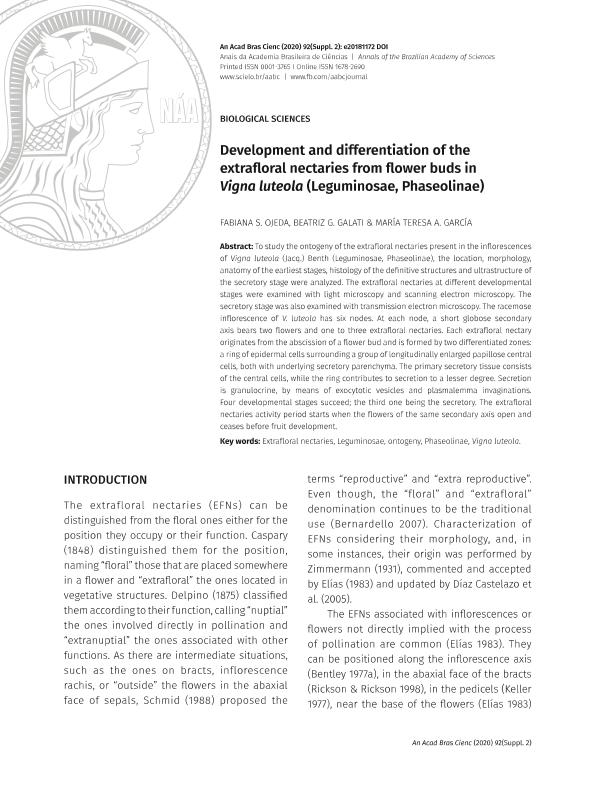Mostrar el registro sencillo del ítem
dc.contributor.author
Ojeda, Fabiana Soledad

dc.contributor.author
Galati, Beatriz Gloria

dc.contributor.author
Amela Garcia, Maria Teresa

dc.date.available
2021-08-03T12:23:21Z
dc.date.issued
2020-10
dc.identifier.citation
Ojeda, Fabiana Soledad; Galati, Beatriz Gloria; Amela Garcia, Maria Teresa; Development and differentiation of the extrafloral nectaries from flower buds in Vigna luteola (Leguminosae, Phaseolinae); Academia Brasileira de Ciencias; Anais da Academia Brasileira de Ciencias; 92; 10-2020; 1-10
dc.identifier.issn
0001-3765
dc.identifier.uri
http://hdl.handle.net/11336/137650
dc.description.abstract
To study the ontogeny of the extrafloral nectaries present in the inflorescences of Vigna luteola (Jacq.) Benth (Leguminosae, Phaseolinae), the location, morphology, anatomy of the earliest stages, histology of the definitive structures and ultrastructure of the secretory stage were analyzed. The extrafloral nectaries at different developmental stages were examined with light microscopy and scanning electron microscopy. The secretory stage was also examined with transmission electron microscopy. The racemose inflorescence of V. luteola has six nodes. At each node, a short globose secondary axis bears two flowers and one to three extrafloral nectaries. Each extrafloral nectary originates from the abscission of a flower bud and is formed by two differentiated zones: a ring of epidermal cells surrounding a group of longitudinally enlarged papillose central cells, both with underlying secretory parenchyma. The primary secretory tissue consists of the central cells, while the ring contributes to secretion to a lesser degree. Secretion is granulocrine, by means of exocytotic vesicles and plasmalemma invaginations. Four developmental stages succeed; the third one being the secretory. The extrafloral nectaries activity period starts when the flowers of the same secondary axis open and ceases before fruit development.
dc.format
application/pdf
dc.language.iso
eng
dc.publisher
Academia Brasileira de Ciencias

dc.rights
info:eu-repo/semantics/openAccess
dc.rights.uri
https://creativecommons.org/licenses/by/2.5/ar/
dc.subject
EXTRAFLORAL NECTARIES
dc.subject
LEGUMINOSAE
dc.subject
ONTOGENY
dc.subject
PHASEOLINAE
dc.subject
VIGNA LUTEOLA
dc.subject.classification
Ciencias de las Plantas, Botánica

dc.subject.classification
Ciencias Biológicas

dc.subject.classification
CIENCIAS NATURALES Y EXACTAS

dc.title
Development and differentiation of the extrafloral nectaries from flower buds in Vigna luteola (Leguminosae, Phaseolinae)
dc.type
info:eu-repo/semantics/article
dc.type
info:ar-repo/semantics/artículo
dc.type
info:eu-repo/semantics/publishedVersion
dc.date.updated
2021-07-30T18:49:53Z
dc.identifier.eissn
1678-2690
dc.journal.volume
92
dc.journal.pagination
1-10
dc.journal.pais
Brasil

dc.journal.ciudad
Rio de Janeiro
dc.description.fil
Fil: Ojeda, Fabiana Soledad. Consejo Nacional de Investigaciones Científicas y Técnicas. Oficina de Coordinación Administrativa Ciudad Universitaria. Instituto de Micología y Botánica. Universidad de Buenos Aires. Facultad de Ciencias Exactas y Naturales. Instituto de Micología y Botánica; Argentina
dc.description.fil
Fil: Galati, Beatriz Gloria. Universidad de Buenos Aires. Facultad de Agronomía; Argentina
dc.description.fil
Fil: Amela Garcia, Maria Teresa. Consejo Nacional de Investigaciones Científicas y Técnicas. Oficina de Coordinación Administrativa Ciudad Universitaria. Instituto de Micología y Botánica. Universidad de Buenos Aires. Facultad de Ciencias Exactas y Naturales. Instituto de Micología y Botánica; Argentina
dc.journal.title
Anais da Academia Brasileira de Ciencias

dc.relation.alternativeid
info:eu-repo/semantics/altIdentifier/url/https://www.scielo.br/j/aabc/a/QPgDn5W9mDrnSSzjbxZQpfG/?lang=en#
dc.relation.alternativeid
info:eu-repo/semantics/altIdentifier/doi/http://dx.doi.org/10.1590/0001-3765202020181172
Archivos asociados
